Bounded Rationality: Definition & Examples
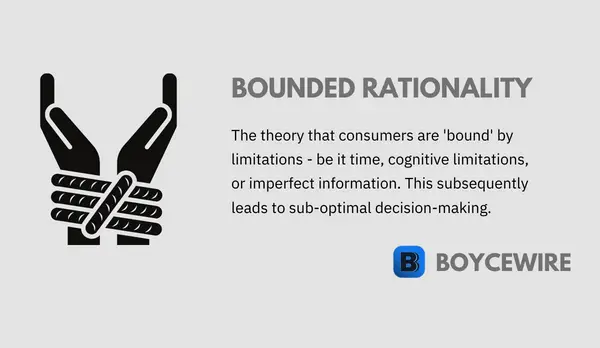
What is Bounded Rationality
The theory of bounded rationality originates from Nobel laureate Herbert Simon. In 1957, he conceptualized the idea in response to rational choice theory, which revolved around the idea that consumers would make optimized economic decisions, as it was in their self-interest to do so. In other words, the consumer would always choose the optimal choice.
Bounded rationality is the theory that consumers have limited rational decision making, driven by three main factors – cognitive ability, time constraint, and imperfect information. For example, when ordering at a restaurant, customers will make suboptimal decisions because they feel rushed by the waiter.
Key Points
- Bounded rationality refers to the cognitive limitations of consumers.
- According to bounded rationality, we make suboptimal decisions due to three factors – cognitive limitations, imperfect information, and time constraints.
- When faced with complex choices, consumers may opt to ‘satisfice’ instead of spending time and effort analyzing the situation – leading to a sub-optimal choice.
Bounded rationality addresses some of the key flaws in the original rational choice theory by highlighting the limitations of humans’ ability to make optimal decisions.
For example, we are ‘bounded’ by limitations such as time constraints, our ability to absorb information, or we may be driven to sub-optimal decisions by emotions and our moods. For instance, it is far more likely that someone starts consuming alcohol after a hard and stressful day at the office.
Bounded Rationality Model
Bounded rationality is based on three main limitations that result in sub-optimal decision making. They are cognitive limitations, imperfect information, and time constraint.

1. Cognitive Limitations
Cognitive limitation refers to our inability as humans to process information in an optimal manner. In other words, we are unable to consider all available factors in our decision making.
For instance, a consumer may need to decide between three types of dessert. They may need to consider many factors. Is it big enough to feed the family and would they like it? If it is too much, would they be able to store it in the fridge? How long does it take before it goes off? Some members prefer desert A, whilst others prefer desert B, which would be best to maximise utility?
As you can tell from the brief example, there are so many questions that need to be answered in order to accurately come to an optimal decision. Most questions won’t even be considered, whilst others just become too overwhelming.
“Cognitive limitation refers to our inability as humans to process information in an optimal manner.”
What happens is that we tend to greatly simplify the decision-making process in order for a decision to be made. For instance, some people can suffer from ‘analysis paralysis’, so they need to simplify the scenario in order to overcome cognitive limitations.
To explain further, we have so many choices today and those choices present an increased level of processing. We only need to look at the number of available laptops or TVs. Even if we had all the information available to us, we have to filter through all of the specs, compare hundreds of options, and come to an optimal decision.
2. Information Imperfection
Information imperfection refers to the lack of information a consumer has. For instance, the average consumer is unlikely to know the difference between an Intel Celeron N3450 Processor and an Intel Celeron N3350. Nor are many consumers likely to spend hours researching what it is and how it affects the performance of their laptop.
There is also information that we don’t necessarily know about. For example, there may be a second-hand store a couple of blocks down that sells the same product for half the price – information that may lead to an optimal decision had the consumer known.
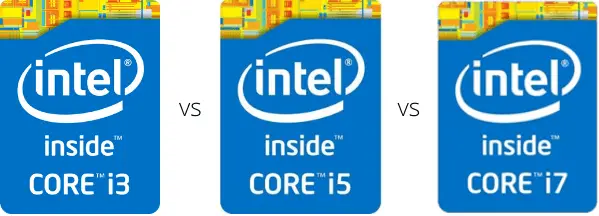
To make better sense of information imperfection, we can use a 2002 quote from the US’ Secretary of State for Defense, Donald Rumsfeld. He stated that there are known knowns, known unknowns, unknown knowns, and unknown unknowns. In regards to information imperfection, we consider unknown knowns and unknown unknowns.
Known knowns are irrelevant for us here as they would help assist with an optimal decision. After all, the consumer has the requisite knowledge.
Known Unknowns
By contrast, we have known unknowns. In other words, the Intel Celeron problem. We know that we don’t know about it and the time and effort for us to do so would also be a waste. This is why review mechanisms have proven so successful and popular.
Unknown Knowns
We then have unknown knowns. This is simply unknown information that is known, just not necessarily to us as consumers. This may cover asymmetrical information or just that the consumer has not come across the information. For instance, a product down the road maybe half the price which may affect the purchasing decision.
Unknown Unknowns
Quite simply there are factors that we don’t know we don’t know. For instance, the harmful effects of cigarettes were not known for many years after they were first introduced to the public. With such information, many would not have even started smoking.
3. Time Constraint
When making a purchase, we often face time constraints. This might occur when we stop at the store during our lunch break or the coffee shop before work. We have places to be and decisions to quickly make. We cannot spend half an hour in the store deciding what is the most optimal lunch we should buy.
There are also management decisions that need to be made with limited information and time. For instance, a business may have an option between two sites to build a new factory. However, the longer it takes to decide, the more money the business may lose.
What time constraints do is constrict our ability to process and analyze a situation and come to an optimal decision. Even for decisions that are not affected by cognitive limitations, those time constraints put pressure on our ability to process new information rapidly.
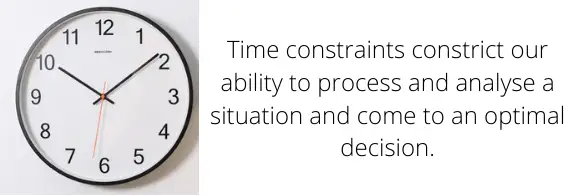
In short, when we are under pressure and time constraints, we make sub-optimal decisions – at least the majority of the time. However, we may make optimal decisions by luck rather than judgment.
If we look at car sales, there is often a significant level of pressure put on the consumer to make a decision on the spot. On occasion, consumers may be offered discounted deals if they take it on the spot. This is to prevent the consumer from walking away and having the time to rationally analyze and compare against other cars and deals.
By putting undue pressure on the consumer to make a decision, they often come to a sub-optimal decision to make the purchase. The time constraint accompanied by the discount can push many consumers to such a decision. It’s an effective technique, but one which comes with unnecessary transaction costs.
Bounded Rationality and Satisficing
Bounded rationality refers to the limitations placed upon us by three main factors, cognitive limitations, information imperfection, and time constraints. So how do we overcome these? The answer is we don’t completely, but rather we satisfice.
To explain, satisficing occurs because of all the previous limitations placed on us. So in order to overcome this, decision-makers place a level by which the outcome is adequate or satisfactory. In other words, a sub-optimal result, but the best they can get.
Satisficing Example
Let us take an example. Mr. Brown is at the store to find a dessert for his wife and two kids. He has three options, a chocolate cake, a cheesecake, or cookies. They like them all, but Mrs. Brown’s favorite is chocolate cake, whilst his first child, Jessica, prefers cheesecake, and Charlotte prefers cookies. Now the cookies are the cheapest, but the chocolate cake can also be saved for the next day.
As we can see, there are a number of factors to consider to reach an optimal decision. Rather than spend half an hour deliberating, Mr. Brown just chooses the cheapest, simply based on cost.
Decision-makers usually simplify the decision-making process into a couple of key factors. This is so that it is easier to process and a decision is actually made. This may be price, value, or something else, but the key factor is that a decision is made that satisfies basic criteria.
Examples of Bounded Rationality
Example #1
Mr. Foley is due to attend his brother’s wedding, but on the day, realizes the shoes he has, have holes in them. He quickly rushes to the store in order to purchase a new pair. There isn’t much time as the wedding starts at 1pm. The number one priority is to find a pair of shoes.
Mr. Foley cannot afford to spend time in making the optimal decision due to the time constraints. Usually, he may take a couple of visits to find the best pair to his liking. However, in this situation, he ‘satisfices’. In other words, his overriding need is a pair of shoes, so prioritizes that over all else.
He ends up paying twice as much for the pair as he would otherwise, thereby leading to economic loss.

Example #2
Mrs. Antle is a CEO at a leading multinational firm with operations in Asia, Europe, North America, and South America. Profits and revenues are falling and shareholders are becoming restless for results.
Mrs. Antle has to make a decision. However, it’s a bit like looking for a needle in a haystack. There is so much information that needs to be compiled to even start to come to a satisfactory decision.
In such a situation, it is virtually impossible for any CEO to make an optimal decision. They have to first compile useful information, but they may be unaware of other information that may, in fact, be useful. Perhaps something an average worker knows that would greatly improve operations.
The fact of the matter is that the chances of the CEO being able to collect all the necessary information is highly unlikely. We then have to consider if they were able to gain all the information, would they be able to effectively analyze what would most likely be thousands upon thousands of pages of data.
In the end, a satisfactory decision is made that meets a limited set of criteria but is not necessarily the most optimal.

Example #3
Jessica goes to her local store to buy some toothpaste. However, there are many choices, each with different qualities. Some are better for sensitive gums, whilst others offer a nice fresh breath. The problem Jessica faces is that she doesn’t know about these.
In the end, a decision has to be made on the limited information available. This is why brands often try and promote their key selling points on the packaging; as this is what the customer will see.
This is partially how brands solve the information constraints, however, it can still lead to sub-optimal outcomes. This is because Jessica as the customer still doesn’t have full information, but has enough to satisfy basic requirements.
She may be after a toothpaste that is helpful with sensitive gums, so those who promote it on their packaging are chosen. However, it might be sub-optimal as it doesn’t consider other factors such as taste. The decision is simplified in order to make it easier to make a decision with limited information.
Related Topics
FAQs
Bounded rationality is attributed to 3 main factors: Cognitive Limitations, Imperfect Information, and Time Constraints. An example of such can be seen when we go to the store to buy a product. We are faced with many choices for hundreds of different products. We don’t really have an idea of which is best for us as we have a limited amount of information on each product. Therefore, we are bounded by factors such as lack of information on each product. As a result, we may choose the product with the best packaging rather than the good that is most optimal.
Rational choice theory revolved around the idea that consumers would make optimise economic decisions as it was in their self-interest to do so. In other words, the consumer would always choose the optimal choice. Bounded rationality is based on three main limitations that result in sub-optimal decision making: Cognitive Limitations, Imperfect Information, and Time Constraints.
Rationality is the idea that as humans we always chose the most optimal decision when it is made in our own self-interest. By contrast, bounded rationality says that we cannot do so as we are limited by three key factors: Cognitive Limitations, Imperfect Information, and Time Constraints.
About Paul
Paul Boyce is an economics editor with over 10 years experience in the industry. Currently working as a consultant within the financial services sector, Paul is the CEO and chief editor of BoyceWire. He has written publications for FEE, the Mises Institute, and many others.

Further Reading
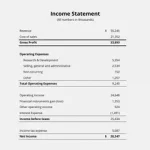 Income Statement: Definition, Format & Example - The income statement details the firm's revenue and expenses during a period of time.
Income Statement: Definition, Format & Example - The income statement details the firm's revenue and expenses during a period of time.  Eminent Domain - Eminent domain is the legal power of a government to expropriate private property for public use, accompanied by the requirement…
Eminent Domain - Eminent domain is the legal power of a government to expropriate private property for public use, accompanied by the requirement… 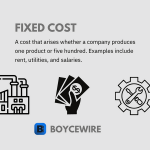 Fixed Cost: Definition, Examples & Effects - A fixed cost is a cost that a business must pay whether it produces one good or a million. Regardless…
Fixed Cost: Definition, Examples & Effects - A fixed cost is a cost that a business must pay whether it produces one good or a million. Regardless… 